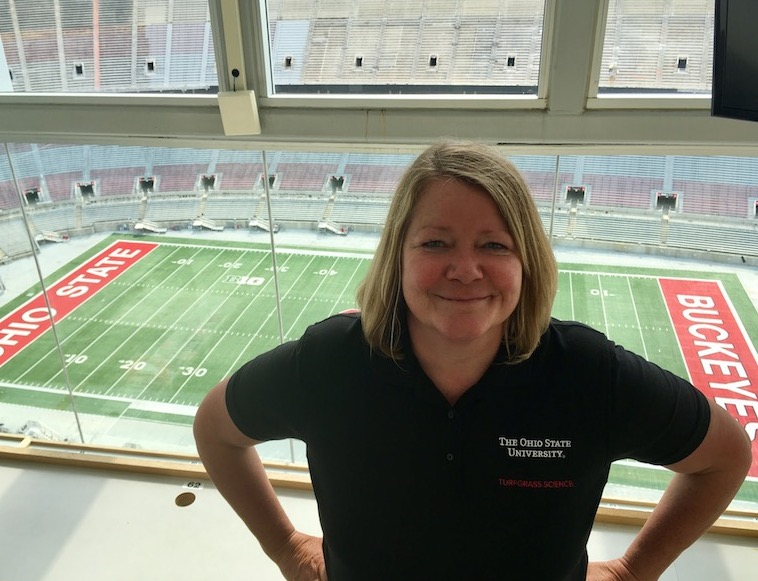Q: Is it worth applying seed as a dormant seed this winter, or should I wait until spring?
A: Great question! Dormant seeding describes the process of applying seed to the field with the knowledge that it will not germinate/will stay dormant until environmental conditions are favorable for germination in spring. For cool-season grasses, that means applying seed during winter, knowing that it will not germinate until soil temperatures at 2” depth are consistently above 50 degrees F. While 50 degrees F soil temperature is the minimum, it’s worth noting that the optimum air temperature for cool-season grass germination is 60-80 degrees F.
In short, it’s absolutely worth it, particularly if you need to get a jump start on game preparation. Early spring sports such as soccer, lacrosse, softball and baseball often begin before the conditions are favorable for regular spring seedings. Getting the seed out in February and early March will offer many benefits: (1) the seed is already in place, ready to germinate when conditions are right; (2) the seed is applied at a time that might not be as busy for the grounds crew; (3) the germinating seed may have a competitive edge on emerging spring weeds; (4) it might be easier to use seed-spreading equipment on fields before spring rains; and (5) the germinating seeds will provide quicker ground cover than a conventional spring seeding.
Applying seed to bare soil or a thin sward is the goal. It is futile to apply seed – dormant or otherwise – to a full, dense sward of existing turfgrass. The existing, established sward cannot be switched out by applying a different seed type as a topdressing. Remember the golden rule of seeding success – there must be optimal seed-soil contact. During the freezing and thawing cycles in late winter, the soil structure changes due to the swelling and shrinkage of soil particles; the volume of frost-susceptible soils increases; and pores expand due to ice expansion during freezing. These soil pores offer a great opportunity for good seed-soil contact.
Seed rates during dormant seeding are generally increased by 30 to 50 percent to account for higher seedling mortality and seed loss through wash-out, birds, etc. If the seed germinates and then a hard frost occurs, there might also be some seedling injury and/or death.
Seed rates and plant health are also worthy of a mention. It’s important not to apply excessive seed amounts for the turf species. While “more is better” is tempting, particularly if there are spring deadlines to meet, the long-term success of the turfgrass plants relies upon having space and resources to fully develop and mature. In essence, larger plants have increased wear tolerance.
Sod farmers will generally seed at, or just below, the recommended seed rate for a good reason. The turfgrass plants will not just grow, but will develop tillers, stolons and rhizomes that are critical during harvest. Those tillers, stolons and rhizomes are also critical for the long-term health of the plant and its ability to withstand athletic field traffic and wear. If seed rates are too high, the seedlings will be weak and susceptible to disease and other stresses.
To spread the seed, walk-behind spreaders/equipment that won’t cause soil damage and compaction are best, but if the soil is dry enough, heavier equipment can be used. That’s often not the case once the soil starts to thaw and spring rains start.
The only product applied during the winter dormant seeding operation should be the seed. Do not add a fertilizer product. In accordance with sound environmental stewardship, fertilizers should never be applied to snow-covered or frozen soils as there is a risk of runoff.
The types of seeds sown will depend on what the end goal is. If quick ground cover is the goal, faster-establishing species such as perennial ryegrass could be used. Tetraploid ryegrasses are an option worth investigating since they can germinate at lower temperatures than the standard perennial types.
A growth blanket is a great tool to aid germination and establishment – especially in high-traffic areas like goal mouths, sidelines, in front of mounds, etc. Growth blankets keep the seed in place by minimizing wash-out; retain moisture and heat, thereby accelerating the establishment rate and extending the growing season; and keep birds and humans off. Whether it is a full-field blanket or a smaller section, it is an invaluable tool that every sports field manager should own.
In summary, yes, go for it – especially if you have to get a jump-start of the season. Aim for optimum seed-soil contact, try tetraploid ryegrass, seed 30 to 50 percent more, do not apply fertilizer, and cover high-traffic spots with a growth blanket.
Pamela Sherratt
Sports turf extension specialist
The Ohio State University
Questions?
Send them to Pamela Sherratt at 202D Kottman Hall, 2001 Coffey Road, Columbus, OH 43210 or sherratt.1@osu.edu
Or send your question to Dr. Grady Miller, North Carolina State University, Box 7620, Raleigh, NC 27695-7620, or grady_miller@ncsu.edu


